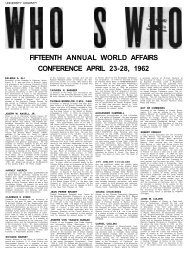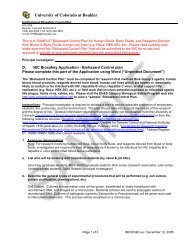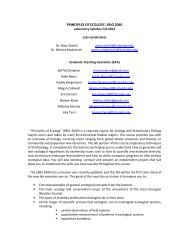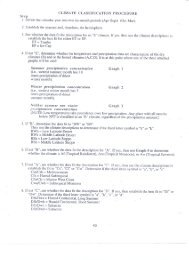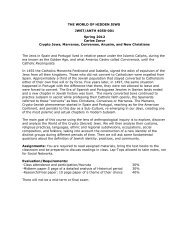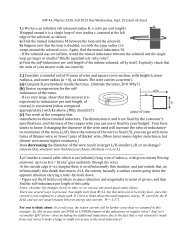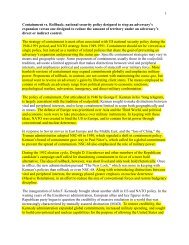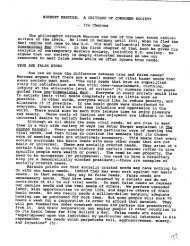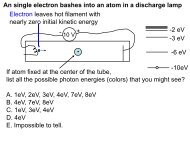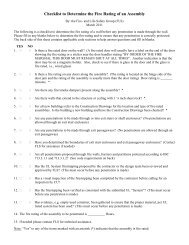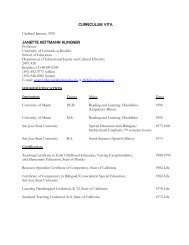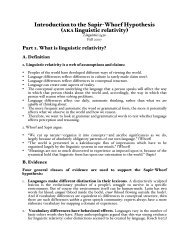Some Applications of Newton's Laws. Solving Fnet = m a problems ...
Some Applications of Newton's Laws. Solving Fnet = m a problems ...
Some Applications of Newton's Laws. Solving Fnet = m a problems ...
You also want an ePaper? Increase the reach of your titles
YUMPU automatically turns print PDFs into web optimized ePapers that Google loves.
<strong>Some</strong> <strong>Applications</strong> <strong>of</strong> Newton’s <strong>Laws</strong>.<br />
NA-1<br />
In this chapter, we get some practice applying Newton’s laws to various physical <strong>problems</strong>. We<br />
do not introduce any new laws <strong>of</strong> physics.<br />
<strong>Solving</strong> <strong>Fnet</strong> = m a <strong>problems</strong> with multiple bodies<br />
Problem: A mass m1 is pulled up a frictionless incline by a string over a pulley and a hanging<br />
mass m2.<br />
no friction<br />
Step 1<br />
Draw a free-body diagram for each moving object.<br />
Step 2<br />
N<br />
m1<br />
We know m1, m2, and the angle .<br />
We seek :<br />
T = tension in the cord,<br />
a = acceleration <strong>of</strong> the mass,<br />
N = normal force on m1<br />
Label the force arrows with<br />
the magnitudes <strong>of</strong> the forces.<br />
Notice that T is the same for<br />
both objects (by NIII).<br />
Use m1, m2, in the diagrams,<br />
not m.<br />
For each object, choose x y axes so that the acceleration vector a is in the (+) direction.<br />
N<br />
m1g<br />
T<br />
+y a<br />
m1g<br />
T<br />
+x<br />
Notice that we can choose<br />
different axes for the different<br />
objects. And we can tilt the<br />
axes if necessary.<br />
2/9/2009 © University <strong>of</strong> Colorado at Boulder<br />
T<br />
m2g<br />
m2<br />
T<br />
m2g<br />
+y<br />
a
Step 3 For each object, write the equations Fx m a x , Fy m a y<br />
m1 :<br />
x-eqn (1) T m gsin m a<br />
1 1<br />
y-eqn (2) N m gcos 0<br />
m2 : (3) m2gTm2a �<br />
Notice that a a<br />
doesn't stretch.<br />
N<br />
1<br />
NA-2<br />
is the same for both m1 and m2 since they are connected by a string that<br />
Now we have a messy algebra problem with 3 equations in 3 unknowns:<br />
(1) T m gsin m a<br />
1 1<br />
(2) N m g cos 0<br />
(3) m g T m a<br />
1<br />
y<br />
1<br />
m1g<br />
2 2<br />
The unknowns are T , N , and a.<br />
We can solve for N right away. Eqn (2) N m1 g cos<br />
Now we have 2 equations [(1) & (3)] in 2 unknowns ( a & T ).<br />
Solve (1) for T and plug into (3) to get an equation without an T :<br />
(1) T m1 gsin m1 a m 1(gsin<br />
a)<br />
(3) m2 g [m 1(gsin a)] m 2 a<br />
a<br />
T<br />
x<br />
m1g<br />
m1g sin<br />
m1g cos<br />
2/9/2009 © University <strong>of</strong> Colorado at Boulder<br />
T<br />
m2g<br />
2<br />
+y<br />
a
Now solve this last equation for a:<br />
NA-3<br />
Finally, if you have any strength left, we can solve for tension T by plugging our expression for<br />
acceleration a back into either (1) or (3) and solving for T. From (3), we have<br />
T m2 g m2 a m 2(g<br />
a) .<br />
Plugging in our big expression for a, we get<br />
T m (g a) m g<br />
2 2<br />
We can simplify:<br />
m2gm1gsin (m m )<br />
1 2<br />
g (m m ) m g m gsin m g m g m g m gsin<br />
T m m<br />
1 2 2 1 1 2 2 1<br />
2<br />
(m1 m 2) (m1 m 2) 2<br />
(m1 m 2)<br />
m g m gsin m m g<br />
1 1 2 1<br />
T m2 T (1 sin )<br />
(m1 m 2) (m1 m 2)<br />
Do these expressions make sense? Let’s check some limits.<br />
m g m gsin m a m a a (m m )<br />
a<br />
2 1 1 2 1 2<br />
m2gm1gsin (m m )<br />
1 2<br />
If m1 = 0, then m2 should be freely falling with a = g and the tension T should be zero. Check<br />
that this is so.<br />
If m2 = 0, then m1 should slide down the incline with acceleration a = –g sin (since it would be<br />
accelerating in the negative direction). Check that this is so.<br />
2/9/2009 © University <strong>of</strong> Colorado at Boulder
Forces and circular motion<br />
NA-4<br />
� �<br />
NII: <strong>Fnet</strong> m a To make something accelerate, we need a force in the same direction as<br />
the acceleration. Centripetal acceleration is always caused by centripetal force, a force<br />
toward center. “Centripetal” means “toward the center”. “Centrifugal” means something totally<br />
different. Centrifugal forces don’t exist! More on that below.<br />
Example: Rock twirled on a string. (Assume no gravity)<br />
2<br />
v 2 r<br />
FT m a m , v ,<br />
r T<br />
r<br />
F.B.D:<br />
( 2<br />
2<br />
r / T) 2 r 2 1<br />
T 2 2<br />
FT<br />
Given: m = 0.1 kg , T (period) = 1 s , radius r = 1 m<br />
What is tension FT in the string ? (Here, we use<br />
symbol FT , since T already taken by period.)<br />
FT is the only force acting. (No such thing as<br />
"centrifugal force"!)<br />
F m 4 m 4 ( 0. 1) 3. 9 N 1 pound<br />
r T 1<br />
What about the outward "centrifugal force"?<br />
A person on a merry-go-round (or twirled on a rope by a giant) "feels" an outward force. This is<br />
an illusion! There is no outward force on the person. Our intuition is failing us. Our intuition<br />
about forces was developed over a lifetime <strong>of</strong> experiences in inertial (non-accelerating) reference<br />
frames. If we are suddenly placed in an accelerating reference frame, our brains (wrongly)<br />
interpret our sense impressions as if we were still in a non-accelerating frame.<br />
The result is that the direction <strong>of</strong> the perceived force is exactly opposite the direction <strong>of</strong> the true<br />
force. Example: A person in car accelerating forward. The chair pushes the driver forward. The<br />
force on the driver is in the forward direction. But the driver "feels" herself pressed back into the<br />
seat. It seems there is some force pushing the driver backward. WRONG!<br />
a<br />
FT<br />
"Centrifugal force" (not to be confused with "centripetal force") is also called a "pseudo-force"<br />
or "fictitious force" . <strong>Newton's</strong> <strong>Laws</strong> are only valid in a non-accelerating reference frame (an<br />
inertial frame). If we try to analyze motion in a non-inertial frame (for instance, in a rotating<br />
2/9/2009 © University <strong>of</strong> Colorado at Boulder
NA-5<br />
frame) then <strong>Newton's</strong> <strong>Laws</strong> don't hold. However, we can pretend that <strong>Newton's</strong> <strong>Laws</strong> hold in an<br />
accelerating frame if we pretend that "pseudo-forces" exist. That is, we can get the right answer<br />
if we makes two mistakes. In my opinion, this is a Devil's bargain. Computational convenience<br />
has come at the price <strong>of</strong> endless confusion <strong>of</strong> millions <strong>of</strong> physics students (and many<br />
pr<strong>of</strong>essional engineers!). My advice: If you have choice, NEVER do calculations in non-inertial<br />
frames. Avoid using fictitious forces.<br />
Consider the rock on the string again (still no gravity). If the string<br />
breaks, then there is no longer any force on the rock and it will move in a<br />
straight line with constant velocity [according to NI: if <strong>Fnet</strong> = 0, then v =<br />
constant]. The reason the rock does not move in a straight line is<br />
because the string keeps pulling it inward, turning it away from its<br />
straight-line path. There is NO outward force on the rock.<br />
Friction ... is very useful! We need friction to walk. Friction is not well understood.<br />
The amount <strong>of</strong> friction between two surfaces depends on difficult-tocharacterize<br />
details <strong>of</strong> the surfaces, including microscopic roughness, cleanliness, and chemical<br />
composition.<br />
-- friction involves tearing, wear between<br />
microscopically rough surfaces.<br />
If two metal surfaces are atomically smooth and clean (almost impossible to achieve), they will<br />
bond on contact = "cold weld".<br />
Empirical observations about friction:<br />
the magnitude <strong>of</strong> the force <strong>of</strong> friction f between 2 surfaces is proportional to the normal force<br />
N, not the area <strong>of</strong> contact, ( f N ).<br />
Pull a block <strong>of</strong> mass m along a surface. Regardless <strong>of</strong><br />
orientation, you get the same normal force (N = mg),<br />
and you get the same frictional force f.<br />
Why not f area <strong>of</strong> contact? Because more area less weight per area.<br />
static friction is different than sliding friction (also called kinetic friction). The maximum<br />
magnitude <strong>of</strong> static friction force usually larger than the magnitude <strong>of</strong> kinetic friction force.<br />
2/9/2009 © University <strong>of</strong> Colorado at Boulder<br />
v
Kinetic Friction (also called sliding friction)<br />
NA-6<br />
f = K N (Not a law, just an empirical observation – usually, but not always, true)<br />
K = coefficient <strong>of</strong> kinetic friction = dimensionless number K > 0<br />
( K can be greater than 1 but, usually, K < 1.)<br />
Example: A block <strong>of</strong> mass m is being pushed along a rough horizontal table. One maintains a<br />
constant velocity v with a horizontal external force <strong>of</strong> magnitude Fext. What is K ?<br />
velocity = constant a = 0 <strong>Fnet</strong> = 0<br />
Free-body diagram: direction <strong>of</strong> frictional force f is always<br />
opposite to the motion:<br />
In y-direction: N = mg In x-direction: Fext = KN So, Fext = K mg, or...<br />
Static Friction<br />
K<br />
F<br />
ext<br />
mg<br />
fstatic < fstatic, max = S N (the maximum magnitude <strong>of</strong> the static friction force is S N)<br />
S = coefficient <strong>of</strong> static friction = dimensionless number S > 0<br />
Usually, S > K (maximum static friction is greater than kinetic friction)<br />
Consider a book sitting on a table. You pull on a book with a small force Fext to the right, but it<br />
doesn't move. There must be a frictional force to the left (otherwise the book would move).<br />
friction<br />
v = const<br />
K = ?<br />
Fext<br />
Fext<br />
friction<br />
f = KN<br />
N Fext<br />
If you increase the external force<br />
and the book still does not move,<br />
the frictional force must have<br />
gotten bigger to match.<br />
If you make the external force big enough, the book will suddenly start to move. Just before the<br />
book moved, the static friction was at its maximum value. So the magnitude <strong>of</strong> the static friction<br />
2/9/2009 © University <strong>of</strong> Colorado at Boulder<br />
Fext<br />
mg<br />
v<br />
y<br />
x
NA-7<br />
force can be anything between zero and a maximum value, given by fmax = S N. The book will<br />
remain stationary until Fext > fmax = S N. Then the book will start to slide.<br />
Usually, S > K large force is needed to start an object sliding, but then a smaller force is<br />
needed to keep it sliding. Anyone who has pushed a fridge across the kitchen floor knows this.<br />
There is no good theory <strong>of</strong> friction 's cannot be computed; instead, they are determined<br />
experimentally.<br />
Example: Friction on an inclined plane<br />
Step 1: Free-body diagram.<br />
Step 2: Choose coordinate system.<br />
(Make direction <strong>of</strong> acceleration = + direction)<br />
Step 3: Fx m a x , Fy m a y<br />
Notice:<br />
x-component <strong>of</strong> weight = –mg sin<br />
y-component <strong>of</strong> weight = –mg cos<br />
Y: ay = 0 +N – mg cos = 0, N = mg cos<br />
X: ax = a +Fext – KN – mg sin m a<br />
Combine X and Y equations:<br />
A mass m on an incline at angle , with kinetic<br />
friction coefficient K. What size external force<br />
Fext is required to maintain an acceleration <strong>of</strong><br />
magnitude a up the incline?<br />
+Fext – K mg cos – mg sin m a Fext ma + K mg cos + mg sin<br />
(Whew! )<br />
a<br />
mg cos<br />
2/9/2009 © University <strong>of</strong> Colorado at Boulder<br />
a<br />
x<br />
y<br />
Fext<br />
mg sin x<br />
mg<br />
f = KN<br />
y
NA-8<br />
Example: A mass m on a flat table, with sliding friction coefficient K, is pulled along the table by<br />
a force Fext at angle . What is the (magnitude <strong>of</strong> the) acceleration a?<br />
K<br />
a = ?<br />
Steps 1, 2:<br />
Step 3:<br />
Y-motion: Fy m a y,<br />
a y = 0 y F 0 (forces up) = (forces down)<br />
N + Fext sin = mg , N = mg – Fext sin (Do you understand the sin here?)<br />
X-motion: Fx m a x,<br />
a x = a Fext cos – KN = m a<br />
Now combine X and Y results:<br />
Fext cos – K(mg – Fext sin = m a<br />
ext<br />
a cos Ksin Kg<br />
notice that all terms have units <strong>of</strong> [a]<br />
2/9/2009 © University <strong>of</strong> Colorado at Boulder<br />
F<br />
�������������<br />
m<br />
Example: Rotation with friction. A car rounds a curve on a flat road (not banked). The radius<br />
<strong>of</strong> the circular curve is r = 100 m, and the speed <strong>of</strong> the car is v = 30 m/s ( 68 mph). How large<br />
a static friction coefficient ( S, not K !) is needed for the car to not skid <strong>of</strong>f the road?<br />
r<br />
m<br />
Top view<br />
a<br />
v<br />
Fext<br />
<strong>Fnet</strong> = Ffric = m a S N = m v 2 / r (car about to skid Ffric = S N )<br />
N = mg S m g = m v 2 / r (m's cancel)<br />
a<br />
Ffric<br />
f = KN<br />
Ffric<br />
N<br />
mg<br />
View from rear <strong>of</strong> car<br />
N<br />
mg<br />
Fext<br />
y<br />
a<br />
x
2<br />
v<br />
2<br />
( 30m/s)<br />
g r ( 9. 8m/s )( 100m)<br />
S 2<br />
0. 92 (no units)<br />
NA-9<br />
So, need S 0.92 or else car will skid. For rubber on dry asphalt S 1.0 , for rubber on wet<br />
asphalt S 0.7. So car will skid if road is wet.<br />
2/9/2009 © University <strong>of</strong> Colorado at Boulder



